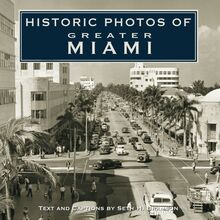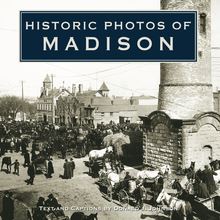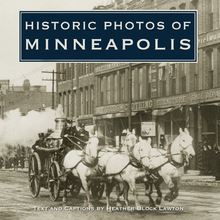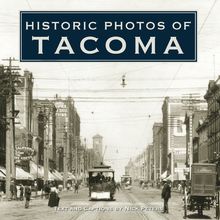Historic Photos of Nashville , livre ebook
203
pages
English
Ebooks
2005
Vous pourrez modifier la taille du texte de cet ouvrage
Obtenez un accès à la bibliothèque pour le consulter en ligne En savoir plus
Découvre YouScribe en t'inscrivant gratuitement
Découvre YouScribe en t'inscrivant gratuitement
203
pages
English
Ebooks
2005
Vous pourrez modifier la taille du texte de cet ouvrage
Obtenez un accès à la bibliothèque pour le consulter en ligne En savoir plus
Publié par
Date de parution
22 septembre 2005
Nombre de lectures
1
EAN13
9781618586575
Langue
English
Poids de l'ouvrage
86 Mo
By the mid-nineteenth century, the city of Nashville was a vibrant cultural center of the South. Through the Civil War reconstruction, two world wars, and into a modern era, Nashville has continued to grow and prosper by overcoming adversity and maintaining the strong independent culture of its citizens.
This volume, Historic Photos of Nashville, captures this journey through still photography from the finest archives of the city, state and private collections. From the Civil War, Exposition and the great fire of 1916, Historic Photos of Nashville follows life, government, education, and disasters throughout Nashville's history. The book captures unique and rare scenes and events through the original lens of hundreds of historic photographs. Published in striking duo tone these images communicate historic events and everyday life of two centuries of people building a unique and prosperous city.
Publié par
Date de parution
22 septembre 2005
Nombre de lectures
1
EAN13
9781618586575
Langue
English
Poids de l'ouvrage
86 Mo
HISTORIC PHOTOS OF
NASHVILLE
T EXT AND C APTIONS BY J AN D UKE
Union Station and the railroad yard, circa 1930. The eight-story building on the left held the offices of the N.C. St.L. Railroad.
HISTORIC PHOTOS OF
NASHVILLE
Turner Publishing Company
200 4th Avenue North Suite 950
Nashville, Tennessee 37219
(615) 255-2665
www.turnerpublishing.com
Historic Photos of Nashville
Copyright 2005 Turner Publishing Company
All rights reserved.
This book or any part thereof may not be reproduced or transmitted in any form or by any means, electronic or mechanical, including photocopying, recording, or by any information storage and retrieval system, without permission in writing from the publisher.
Library of Congress Control Number: 2005926683
ISBN-13: 978-1-59652-184-1
ISBN: 1-59652-184-8
Printed in China
09 10 11 12 13 14 15 16-0 9 8 7 6 5 4 3
C ONTENTS
A CKNOWLEDGMENTS
P REFACE
P RE -C IVIL W AR TO THE C ENTENNIAL (1850-1899)
A C ITY AT THE T URN OF THE C ENTURY (1900-1916)
T HE F IRST W ORLD W AR AND A D EVELOPING M ETROPOLIS (1917-1939)
A M ODERN C ITY E MERGES (1940-1979)
N OTES ON THE P HOTOGRAPHS
This photograph captures shadows of the Parthenon columns.
A CKNOWLEDGMENTS
This volume, Historic Photos of Nashville , is the result of the cooperation and efforts of many individuals, organizations, and corporations. It is with great thanks that we acknowledge the valuable contribution of the following for their generous support:
AmSouth Bank
First Tennessee
KraftCPAs PLLC
LBMC
Pinnacle Financial Partners
Tennessee State Library and Archives
US Bank
Bass, Berry Sims
FirstBank
LifeWay
The Nashville Room-Nashville Public Library
Southern Baptist Historical Library and Archives
Tennessee Historical Society
Vanderbilt University Library and University Archives
We would also like to express our gratitude to Phil Duke for providing research, assisting the author, and contributing in all ways possible.
Finally, we would like to thank the following individuals for their valuable contribution and assistance in making this work possible:
Steven Gateley, Research Service Librarian, LifeWay
Susan Gordon, Archivist, Tennessee State Library and Archives
Lyle Lankford, Public Affairs Office, Vanderbilt University
Beth Odle, Special Collections Division, Nashville Public Library
Henry Shipman, Photographic Assistant, Vanderbilt University Library
Bill Sumners, Director, Southern Baptist Historical Library and Archives
Ridley Wills II, Historian
P REFACE
Nashville has thousands of historic photographs that reside in archives, both locally and nationally. This book began with the observation that, while those photographs are of great interest to many, they are not easily accessible. During a time when Nashville is looking ahead and evaluating its future course, many people are asking, How do we treat the past? These decisions affect every aspect of the city-architecture, public spaces, commerce, and infrastructure-and these, in turn, affect the way that people live their lives. This book seeks to provide easy access to a valuable, objective look into the history of Nashville.
The power of photographs is that they are less subjective than words in their treatment of history. Although the photographer can make subjective decisions regarding subject matter and how to capture and present it, photographs seldom interpret the past to the extent textual histories can. For this reason, photography is uniquely positioned to offer an original, untainted look at the past, allowing the viewer to learn for himself what the world was like a century or more ago.
This project represents countless hours of review and research. The researchers and writer have reviewed many hundreds of photographs in numerous archives. We greatly appreciate the generous assistance of the individuals and organizations listed in the acknowledgments of this work, without whom this project could not have been completed.
The goal in publishing this work is to provide broader access to this set of extraordinary photographs, as well as to inspire, provide perspective, and evoke insight that might assist citizens as they work to plan the city s future. In addition, the book seeks to preserve the past with adequate respect and reverence.
With the exception of touching up imperfections that have accrued with the passage of time and cropping where necessary, no changes have been made. The focus and clarity of many images is limited by the technology and the ability of the photographer at the time they were taken.
The work is divided into eras. Beginning with some of the earliest known photographs of Nashville, the first section records photographs from before the Civil War through the Centennial. The second section spans the beginning of the twentieth century to World War I. Section Three moves from WW I to World War II. And finally, Section Four covers from WWII to the late 1970s.
In each of these sections, we have made an effort to capture various aspects of life through our selection of photographs. People, commerce, transportation, infrastructure, religious institutions, and educational institutions have been included to provide a broad perspective.
We encourage readers to reflect as they walk in front of the State Capitol, along the riverfront, or through Centennial Park. Cannons were once positioned on the Capitol steps, steamboats once lined the banks of the Cumberland, and many buildings, long since demolished, surrounded the Parthenon in Centennial Park. It is the publisher s hope that in utilizing this work, longtime residents will learn something new and that new residents will gain a perspective on where Nashville has been, so that each can contribute to its future.
-Todd Bottorff, Publisher
Nashville Town Square showcases horse-drawn wagons in the streets. This is one of the earliest known photographs of Nashville. The Davidson County Courthouse is on the left.
P RE -C IVIL W AR TO THE C ENTENNIAL
1850-1899
By the 1850s, Nashville had earned the name Athens of the South by establishing the University of Nashville, Nashville Female Academy, and a promising public school system. By the end of the century, Nashville saw Fisk University, Montgomery Bell Academy, Meharry Medical College, Peabody Normal College, and Vanderbilt University open their doors.
At the time, Nashville was known to be one of the more refined and educated cities of the South. It had several theaters as well as many elegant accommodations. The city saw the completion of the majestic State Capitol in 1859. Nashville was a vibrant, expanding town, but that prosperity was interrupted with the beginning of the Civil War in 1861. That conflict devastated Nashville and its residents until its end in 1865.
Following the Civil War, Nashville began rebuilding and grew once again with the opening of Vanderbilt University in 1875, the completion of Jubilee Hall in 1876, General Hospital in 1890, the Union Gospel Tabernacle in 1892, a new state prison in 1898, and finally Union Station in 1900.
In the development of transportation, Nashville experienced the arrival of the first steam locomotive in 1850 and mule-drawn streetcars in 1865, only to replace them with electric trolleys in 1889. In 1896, the first automobile was driven in Nashville.
Nashville also witnessed its first professional baseball game at Athletic Field in 1885 and its first football game in 1890. The city received the world s first airmail by balloon in 1877, the same year telephones appeared. Three years later, in 1880, Nashville s first electric light was turned on. In the latter part of the nineteenth century, the city had two important celebrations: Nashville s Centennial in 1880, followed by the Tennessee Centennial Exposition in 1897.
The period during the second half of the nineteenth century was marked by early progress, interrupted by destruction, and closed with rebirth and new prosperity for the Athens of the South.
In 1859, men in suits pose for the camera at the storefront of the Benjamin T. Johnson Company Confectionery.
Hymes School, pictured here, was built in 1857 on the corner of Lime and Summer streets.
During the Battle of Nashville in 1864, men guard the fortified bridge over the Cumberland River. The battle lasted two days and ended in a major Union victory.
The Cumberland Railroad Bridge was fortified during the Civil War. Perhaps this youngster was supervising the fortification on his horse.
Ft. Negley was built in 1862 on St. Cloud Hill and was occupied by the Federal forces in Nashville. This picture shows the reconstructed fort built by the WPA in the 1930s.
Pictured here around 1862-64 is the Federal Army field hospital on the western outskirts of Nashville. The dirt road on the left is Spring Street leading into town toward the Masonic Hall and the First Presbyterian Church, one tower of which is visible on the horizon.
This Federal Army camp in Nashville looks west from near Fort Negley in 1864.
Shown here in 1863 is a military encampment at the foot of the State Capitol. The Capitol building is seen under construction.
Covered artillery looks down from the steps of the armed Capitol around 1864.
This 1864 view from the State Capitol was recorded on a rainy day. A man is seen resting against one of the statues.
A Civil War photograph taken from the roof of Lindsley Hall shows the three-story College Hill Armory with its tall smokestack in the center, and Fort Negley beyond and slightly to the left. The building in the foreground housed the Literary Department of the University of Nashville.
The University of Nashville s Lindsley Hall was built in 1855. During the Civil War, it was used by Confederate and Union forces as a hospital.
The Nashville Wharf (Front Street), circa 1875.
Front Street along the riverfront is unpaved in this photograph from the late 1800s.
Constructe














